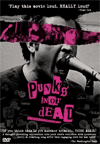Punk's Not Dead
A large portion of my journalism gigs to this point revolve around heavy metal and punk rock. Sad to see that what was already fought and issued a truce for in the late eighties has resurfaced though not with the same brute ugliness, happy to say. I'm talking about the lurking subdivision between aggregate fringe cultures, the metal sanction and the punk sanction. Of course, today the music is far different than it was for both affiliates back then and yes, punk rock is likely the more exploited (not the legendary hardcore band, I assure you) demographic in terms of commodity trade when the fine line between Good Charlotte and The Buzzcocks finds the former in a hefty recording contract while the latter crops up now then as a reminder of punk rock in a relatively simpler time.
Still, to hear the headbangers of today bully punkers through the private anonymity of cyberspace when the threat was real back in a pre-internet existence, said chowderbrain behavior is hopeless as it is artificial. Hey kids, we got our shit together back in the day, so much that metalheads of the eighties flocked to the refreshing angst of punk bands such as Bad Brains, Circle Jerks, The Jam, Agent Orange, Dead Kennedys, GBH, Black Flag, JFI, Youth of Today, Social Distortion and Discharge, all as metal was slipping the into the mire of commercialism. In turn, punkers grudgingly yielded an attraction for Black Sabbath, Iron Maiden, AC/DC and Saint Vitus. Years later, we can hold intelligent conversations amongst ourselves and bring up bands we loved from each other's sides, also mentioning later bands like Quicksand and Helmet as mutual love affairs.
The dismissal of hostilities and the acceptance of one another in the capitalist-driven eighties inevitably led to the formation of crossover, in which renowned punk bands such as DRI, Broken Bones and Suicidal Tendenices morphed into thrash metal acts after the celebrated hybrid unit SOD altered the rules of the entire subculture with their blazing speedpunk gem, Speak English Or Die. Almost by attrition, the speed metal units and their acolytes suddenly admitted punk affinities for The Misfits, The Dickies, Cro Mags, Straw Dogs, Black Market Baby, Adrenalin OD, The Damned, Government Issue, Angry Samoans, Fear and The Dead Boys. Seriously, if you break things down properly, both metal and punk were cut from the same mold; somewhere after MC5 and the New York Dolls, the styles veered in different directions and different motives, but both concentrated on extracting the loudest din possible from their varied execution.
While this boundary-crossing phenomenon isn't exactly addressed on Susan Dynner's ambitious documentary film "Punk's Not Dead," Dynner's movie is one of the few to actually dig past The Sex Pistols and The Ramones, two influential bands who seem to be the go and the stop points in punk for many music retrospectives. Dynner digs so deep we get to visit figureheads of eighties punk and hardcore such as Ian MacKaye of Minor Threat and Fugazi, Jello Biafra, Henry Rollins, Keith Morris of the Circle Jerks, Charlie Harper of the UK Subs, Wattie of The Exploited, Colin "Jock" Blyth of GBH, Brian Baker of Minor Threat, Dag Nasty and Bad Religion and Dick from the Subhumans.
Briefly touching on punk's formative years and taking for granted everyone watching this film has already heard enough of how Blondie, Patti Smith and the Talking Heads were the darlings of CBGB's who started as punk then went new wave and alternative rock, "Punk's Not Dead" focuses itself more on the phenomenon of punk rock, partially from a sociological perspective and largely from an economic and fundamental standpoint. As we hear hardcore myths of yesteryear and how bands tended to crash at strangers' homes on tour (many with those whom they'd sent pre-ordered albums to), slept under buses in the winter snow and essentially got by in what is now proudly heralded as a DIY (or do-it-yourself) ethos, "Punk's Not Dead" explores the gradual industrialist nature that has turned a counterculture movement into a cash cow.
As Billie Joe Armstrong of Green Day and The Offspring's Dexter Holland lend their views to the film, the underlying point "Punk's Not Dead" makes is that the gross rebelliousness of punk ended in the wake of the late GG Allin and Jello Biafra's tenure with the Dead Kennedys. Following the camera's lens into a Hot Topic store where kids today can grab merch of their favorite pop-oriented punk bands instead of a sweaty club they've had to slam-dance within, "Punk's Not Dead" sarcastically drives home the cheerless reality that a formerly anti-establishment sound has now become corporate-sponsored and to many minds, corporate backwashed.
Left in the wake of "Punk's Not Dead's" theorem is the residual debate as to whether the constitution of modern punk rock acts varying from Thursday to Hawthorne Heights to Good Charlotte to The Mars Volta makes them all true punk. Bringing enthusiastic opinions for both sides of the issue, this is the airy question posited and strayed asunder with little resolution. In exchange, however, "Punk's Not Dead" hoists high octane vintage footage and comical retrospection from its widely-varied cut-up cast. Whether you were straight edge, hardcore, regular punk, mohawked or just the kid in drab clothes with a hankering for excitably rude music, "Punk's Not Dead" is a breath of fresh air with a rootsy and loving orientation for its subject. It's a nodding reminder that punkers of the late seventies and eighties paid all the dues with baseball bats cracked over their domes from hateful farmers (and at one point, metalheads), violent forms of retribution for individualism that seldom come up tendered to a new generation bopping to more effervescence and less tension than what originated the genre to begin with. Of course, individualism in punk rock and heavy metal is questionably conformist more so today than it ever was.







